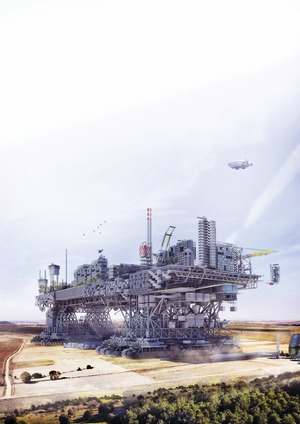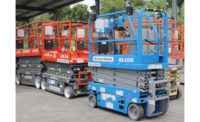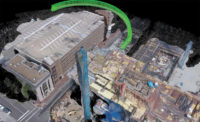Dream Projects: City-on-Treads Goes Wherever It Wants

The Very Large Structure is a concept for a 600-foot tall city on treads weighing over 300,000 tons.
The Very Large Structure (VLS) is described as a 600-ft-tall "city on wheels" that would remain in almost constant motion as it rolled over the countryside. Consisting of a massive superstructure on a 1,700-ft-long platform born along by massive tank-style treads, the VLS would concentrate all of the activities and resource consumption of a city into a single mobile structure.
 |
The project was designed by Spanish architect Manuel Domíguez in 2012 for his thesis at the Superior Technical School of Architecture of the Technical University of Madrid (ETSA), and is intended to highlight issues with energy consumption of large cities. Unlike a traditional fixed-location city, the VLS would be able to move to new locations depending on changes in resource availability and climate.
Domínguez estimates that the entire structure would weigh between 300,000 and 320,000 tons, including the buildings on the superstructure. His own rough calculations show a need for 1,016 MW of power to move the city, which he proposes reaching through a combination of 36 generators rated at 29MW each.
While the basic structural elements of the VLS are relatively fixed, the occupied spaces of the structure would be made of box-shaped modular units, which could be reconfigured and stacked into difference arrangements as needed. In Domínguez's vision, the VLS would evolve and be redesigned as necessary, much like a real city. Rather than have a fixed endpoint, the structure would be renovated and expanded as needs dictated, and this is reflected to the modular design of the superstructure.
In addition to onboard solar panel arrays, the VLS would have a massive battery bank to store power drawn from nearby renewable resources. Retractable water pumps could be deployed to take on potable water, and cranes mounted around the support columns would be able to take on supplies. There would also be helipads and access points for blimps to be moored.
The idea of a self-contained mobile structure offering all the advantages of a city is not a new idea. The VLS is in some ways an update of the "Walking City" proposed by architect Ron Herron in the journal Archigram in the 1960s, where six-legged behemoth cities would creep over the landscape. Both projects draw inspiration not only from science fiction but also the massive self-propelled transport platforms NASA used to move its rockets to their launch positions. The VLS also draws inspiration from the efficient management of space and weight seen on offshore oil platforms. In many ways the self-contained mobile city of the VLS is similar in organization to the "floating city" of a fully staffed aircraft carrier.



